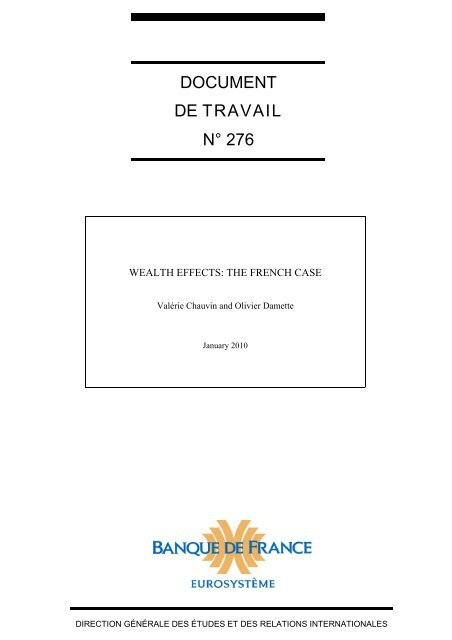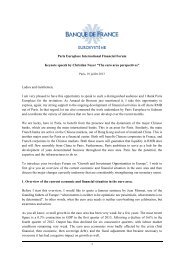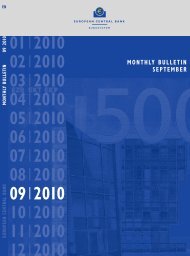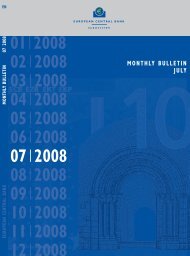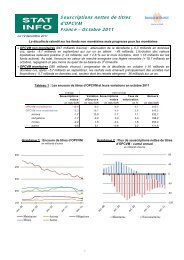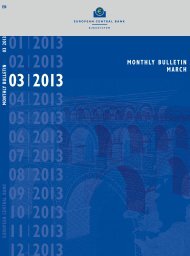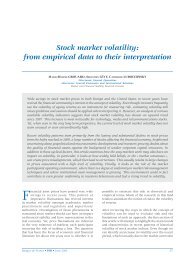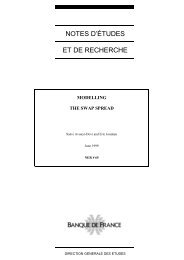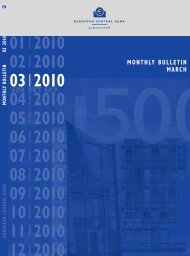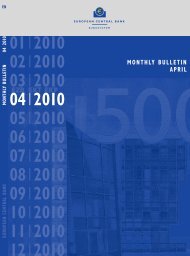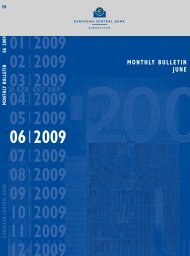WEALTH EFFECTS: THE FRENCH CASE - Banque de France
WEALTH EFFECTS: THE FRENCH CASE - Banque de France
WEALTH EFFECTS: THE FRENCH CASE - Banque de France
Create successful ePaper yourself
Turn your PDF publications into a flip-book with our unique Google optimized e-Paper software.
DOCUMENT<br />
DE TRAVAIL<br />
N° 276<br />
<strong>WEALTH</strong> <strong>EFFECTS</strong>: <strong>THE</strong> <strong>FRENCH</strong> <strong>CASE</strong><br />
Valérie Chauvin and Olivier Damette<br />
January 2010<br />
DIRECTION GÉNÉRALE DES ÉTUDES ET DES RELATIONS INTERNATIONALES
DIRECTION GÉNÉRALE DES ÉTUDES ET DES RELATIONS INTERNATIONALES<br />
<strong>WEALTH</strong> <strong>EFFECTS</strong>: <strong>THE</strong> <strong>FRENCH</strong> <strong>CASE</strong><br />
Valérie Chauvin and Olivier Damette<br />
January 2010<br />
Les Documents <strong>de</strong> travail reflètent les idées personnelles <strong>de</strong> leurs auteurs et n'expriment pas<br />
nécessairement la position <strong>de</strong> la <strong>Banque</strong> <strong>de</strong> <strong>France</strong>. Ce document est disponible sur le site internet <strong>de</strong> la<br />
<strong>Banque</strong> <strong>de</strong> <strong>France</strong> « www.banque-france.fr ».<br />
Working Papers reflect the opinions of the authors and do not necessarily express the views of the <strong>Banque</strong><br />
<strong>de</strong> <strong>France</strong>. This document is available on the <strong>Banque</strong> <strong>de</strong> <strong>France</strong> Website “www.banque-france.fr”.
Wealth effects: the French case ∗<br />
Valerie Chauvin † , Olivier Damette ‡<br />
∗ All views expressed in the paper are only those of the authors and are not necessarily<br />
those of the <strong>Banque</strong> <strong>de</strong> <strong>France</strong>. We wish to thank warmly Françoise Charpin, Pierre Morin,<br />
John Muellbauer and the participants of the JRP meeting in <strong>Banque</strong> <strong>de</strong> <strong>France</strong> (2009) as well<br />
as participants of the AFSE conference (2009) for helpful comments.<br />
† <strong>Banque</strong> <strong>de</strong> <strong>France</strong>, DGEI-DCPM-SEMAP.<br />
‡ University Paris12, ERUDITE<br />
1
Abstract<br />
This paper studies the relationship between consumption and wealth based<br />
on the concept of cointegration. The analysis focuses on French data over the<br />
1987 - 2006 period. This relationship is expressed in two ways: in terms of<br />
Marginal Propensity to Consume out of wealth (MPC) and in terms of Elasticity<br />
of consumption to wealth. Three concepts of consumption are investigated:<br />
total households consumption expenditure, consumption excluding financial services<br />
and consumption excluding durable goods. Different estimators are also<br />
consi<strong>de</strong>red. Based on the MPC approach, when consi<strong>de</strong>red as permanent by<br />
households, an increase (<strong>de</strong>crease) in total wealth of one euro would lead to an<br />
increase (<strong>de</strong>crease) of 1 cent in total consumption. In terms of elasticity, an<br />
increase (<strong>de</strong>crease) of 10% in wealth would imply also a relatively small impact<br />
of 0.8 to 1.1% on consumption <strong>de</strong>pending on the concept of consumption consi<strong>de</strong>red.<br />
In most cases, the effect of a change in financial wealth is bigger than of a<br />
change in housing wealth. The results indicate that the wealth effects in <strong>France</strong><br />
are smaller than in the UK and US but close to what is observed in Italy. In<br />
addition, any <strong>de</strong>viation of the variables from their common trends is corrected<br />
at first by adjustments in disposable income in line with what has been uncovered<br />
by studies on Germany and consistent with the ”saving for the rainy days”<br />
approach of Campbell (1987). But our results contrast with the seminal study<br />
of Lettau and Ludvigson (2004) in the US where asset prices make the bulk of<br />
the adjustment.<br />
Keywords: consumption, wealth effect, <strong>France</strong><br />
JEL classification: E21 E32 C22 G12 G20<br />
Résumé<br />
Alors que les prix <strong>de</strong>s actifs ont considérablement baissé suite à la crise<br />
<strong>de</strong>s subprimes, cet article étudie le lien entre la richesse et la consommation.<br />
Plus spécifiquement, nous estimons les effets richesse en <strong>France</strong> sur la pério<strong>de</strong><br />
1987-2006 par le bais <strong>de</strong>s techniques <strong>de</strong> cointégration en séries temporelles.<br />
L’approche est comparative car les estimations sont réalisées à partir <strong>de</strong>s <strong>de</strong>ux<br />
principales approches théoriques <strong>de</strong> la littérature sur les effets richesse, prennent<br />
en considération plusieurs concepts <strong>de</strong> consommation et reposent sur trois<br />
métho<strong>de</strong>s d’estimation différentes. Au final, les estimations sont stables et convergentes<br />
et les effets richesse en <strong>France</strong> apparaissent significatifs mais modérés.<br />
Mots-clés: consommation, effet <strong>de</strong> richesse, <strong>France</strong><br />
Co<strong>de</strong>s JEL: E21 E32 C22 G12 G20<br />
2
1 Introduction<br />
Following the subprime crisis, asset prices lost more than half their value between<br />
June 2007 and April 2009. At the same time, activity and both business<br />
and consumer surveys plummeted. Hence a crucial question for monetary policy:<br />
is the impact of the financial crisis on activity permanent and what is its<br />
magnitu<strong>de</strong> Asset prices may impact economic activity via different channels.<br />
In this paper, we will focus on the wealth effect in <strong>France</strong>, restricted to the link<br />
between asset prices and households’ consumption.<br />
Using cointegration techniques, we estimate the relationship between households’<br />
consumption, disposable income and wealth. Aggregated and disaggregated<br />
(financial and housing) measures of wealth are consi<strong>de</strong>red and several<br />
concepts of consumption are analyzed. Furthermore, two different functional<br />
forms (marginal propensity to consume and elasticity) are tested here, contrary<br />
to other studies on this topic, especially consi<strong>de</strong>ring the French case. Besi<strong>de</strong>s,<br />
a comparison of several estimators is <strong>de</strong>rived. Following several papers in the<br />
literature (e.g. Lettau and Ludvigson, 2004) we try to assess how much of the<br />
wealth movements are consi<strong>de</strong>red as permanent and thus may influence consumption.<br />
All in all, there is some evi<strong>de</strong>nce of a small but robust wealth effect<br />
in <strong>France</strong>, whatever the approaches consi<strong>de</strong>red.<br />
The remain<strong>de</strong>r of this article is organized as follows. In the first part, we<br />
present the theoretical mo<strong>de</strong>ls un<strong>de</strong>rlying our approach. The second part <strong>de</strong>scribes<br />
the existing results concerning the French case. Finally, our results are<br />
<strong>de</strong>rived and analyzed in the third part.<br />
2 Theoretical background<br />
The theoretical mo<strong>de</strong>ls <strong>de</strong>veloped in or<strong>de</strong>r to assess the impact of asset prices<br />
on consumption can be divi<strong>de</strong>d in two main categories.<br />
2.1 Mo<strong>de</strong>ls based on budget constraint<br />
Following Campbell and Mankiw (1989), Lettau and Ludvigson (2001) <strong>de</strong>rived<br />
from the household budget constraint the existence of a cointegrating relationship<br />
between consumption, income and the components of wealth. As long<br />
as consumers are forward-looking, the gap between the observed variables and<br />
their long term equilibrium may convey information on the future <strong>de</strong>velopment<br />
of consumption but also asset prices and income (Lettau and Ludvigson, 2004).<br />
Campbell and Mankiw (1989), by rearranging the log-linearized budget constraint<br />
for total wealth which is <strong>de</strong>fined as the sum of observable assets and<br />
human capital, found the following relationship:<br />
∑<br />
∞<br />
(c t − w t ) ≈ E t ρ k w(rt+k w − ∆c t+k ) (1)<br />
k=1<br />
where c t , w t and r t <strong>de</strong>note the log of consumption, total wealth and gross return<br />
on total wealth, and ρ w ≡ 1 − exp(c − w). The ratio of consumption to total<br />
wealth on the left hand si<strong>de</strong> of the equation gives information on the future<br />
3
<strong>de</strong>velopments of consumption and asset prices on the right hand si<strong>de</strong> of the<br />
equation.<br />
Moreover, if the term on the right hand si<strong>de</strong> of equation (1) is stationary, then<br />
consumption and wealth (broadly <strong>de</strong>fined) should be cointegrated. The problem<br />
is that, with the inclusion of human wealth, total wealth is not observable,<br />
so that the link cannot be tested empirically. Lettau and Ludvigson (2001)<br />
modified equation (1) by making assumptions about the unobserved human<br />
wealth. They first assume that the share ω of observable asset value a t in total<br />
wealth is approximately constant and that the average return of overall wealth<br />
is a weighted sum of return on assets. They also assume that the nonstationary<br />
component of human wealth can be captured by aggregate labour income Y t .<br />
So that they obtain the following equation linking observable data:<br />
cay t ≡ c t −ωa t −(1−ω)y t ≈ E t<br />
∞ ∑<br />
k=1<br />
ρ k w[ωr a t+k+(1−ω)r h t+k−∆c t+k ]+(1−ω)z t (2)<br />
where z t is a stationary zero-mean variable. One of the pitfalls of this approach<br />
is that ω cannot be observed. However, if the return on wealth and expected consumption<br />
growth are assumed to be stationary, cay t is stationary as well. This<br />
implies a cointegration relationship between log consumption, assets and labor<br />
income. ω can then be estimated superconsistently by cointegration methods.<br />
Lettau and Ludvigson (2004) estimate the parameters of the cay t series following<br />
Stock and Watson (1993). In a VECM (Vector Error Correction Mo<strong>de</strong>l)<br />
framework, they find that <strong>de</strong>partures of cay t from its long run value in the US<br />
help forecast the returns on SP 500 stock in<strong>de</strong>x rather than consumption.<br />
2.2 Mo<strong>de</strong>ls based on the consumption function<br />
The approach <strong>de</strong>veloped above is very parsimonious, which makes it attractive.<br />
However, as it uses only the information contained in the budget constraint,<br />
it obviously misses some characteristics of the consumer behaviour that can be<br />
assessed for instance via the complete analysis of the consumer’s program at the<br />
aggregate level. Moreover, the analytical resolution of the consumer’s program<br />
may lead to a different functional link between consumption and wealth. Three<br />
features seem important in that respect.<br />
Firstly, if the consumer utility function is quadratic or isoelastic, its consumption<br />
is equal to his/her permanent income and thus proportional to its<br />
total wealth, which can be separated in assets and human wealth. Consi<strong>de</strong>ring<br />
that human wealth is <strong>de</strong>termined by the current non property income:<br />
C t = W t<br />
κ<br />
= A t + W h t<br />
κ<br />
= A t<br />
κ + Y t<br />
κ h<br />
(3)<br />
where C t , W t , A t , W h t and Y t <strong>de</strong>note respectively consumption, total wealth,<br />
assets, human wealth and non property income. According to Altissimo et alii<br />
(2005), theoretical mo<strong>de</strong>ls would set potential values of 1 κ<br />
between 3 and 10.1<br />
1 1<br />
r<br />
More precisely, in the case of a constant risk aversion, tend to a<br />
as the horizon of<br />
κ 1+r a<br />
the consumer tends towards infinity, where R a = 1 + r a <strong>de</strong>notes the average return of non<br />
human wealth. In the case of an isoelastic utility function and Blanchard’s(1985) finitely<br />
living overlapping generations mo<strong>de</strong>l, 1 ≈ σ · ρ + (1 − σ) · ra + π where ρ, σ and π respectively<br />
κ<br />
<strong>de</strong>note the subjective discount rate, the intertemporal elasticity of substitution (the inverse<br />
of risk aversion) and the constant probability of <strong>de</strong>ath. Usual values of these parameters lead<br />
to the range mentioned before.<br />
4
Secondly, households consume housing services whereas they do not consume<br />
services from their non housing assets. In autarky, households are either renters<br />
or owners. If housing prices rise, owners are better off, whereas renters (or<br />
future owners) are worse off, preferring that housing prices fall. Thus housing<br />
prices play a role in the distribution of wealth, but not necessarily on aggregate<br />
consumption, if all consumers have the same utility function for example. The<br />
only potential source of wealth effect is a bubble in the housing market. In<br />
the recent literature, both Muellbauer (2008) 2 and Buiter (2008) 3 stress the<br />
difference between both kind of assets. The results above are partly due to the<br />
fact that the financial markets are assumed to be perfect. Credit constraints<br />
may change the role of housing prices on consumption in two opposite ways.<br />
Credit constraints for the first time buyers, who must save for the minimum<br />
<strong>de</strong>posit required to get onto the owner-occupied housing lad<strong>de</strong>r, oblige the young<br />
to save all the more as prices are high. Thus, these constraints reinforce the<br />
negative impact of housing prices on consumption, compared to the results<br />
of the theoretical mo<strong>de</strong>ls <strong>de</strong>veloped above, but consumption smoothing is not<br />
affected. On the contrary, higher housing prices boost home equity loans and<br />
consumption in some countries such as the US, where housing wealth may be<br />
used as collateral to buy consumer goods.<br />
Thirdly, Carroll, Otsuka, Slacalek (2006) remind that taxes 4 , <strong>de</strong>mographics,<br />
productivity growth, financial structure and regulation, interest rates, social<br />
insurance among others have changed, so that the cointegrating vector between<br />
consumption, income and wealth may not be stable. In<strong>de</strong>ed, Rudd and Whelan<br />
(2006) do not find any cointegrating vector for the US. Muellbauer (2008) and<br />
Barrell and Davis (2007) insist on the fact that the estimation of wealth effects<br />
may be biased by omitted variables. These previous studies lead us to carefully<br />
assess the robustness of our results, both over time and by controlling for omitted<br />
variables.<br />
3 Wealth effect approach <strong>de</strong>bate and empirical<br />
estimations for <strong>France</strong><br />
We first discuss the respective merits of consumption elasticities and marginal<br />
propensity to consume out of wealth as measures of wealth effect and then, in<br />
the light of the previous <strong>de</strong>bate, the existing literature for <strong>France</strong>.<br />
3.1 Elasticities versus marginal propensity to consume<br />
As seen in section 2, the effect of wealth on consumption may be measured via<br />
two methods, which have been indifferently <strong>de</strong>veloped by various authors. One<br />
measure is the elasticity of consumption to wealth (section 2.1), which is the<br />
percentage change of consumption to be expected after a 10 percentage point<br />
2 In a life-cycle permanent income mo<strong>de</strong>l for a single representative agent where the future<br />
relative price of housing is expected to be constant.<br />
3 In a more <strong>de</strong>veloped framework, such as the general equilibrium mo<strong>de</strong>l where there is no<br />
life-cycle-related effects on the <strong>de</strong>mand for housing service (the Yaari-Blanchard overlapping<br />
generations mo<strong>de</strong>l).<br />
4 In <strong>France</strong>, owner occupiers do not pay taxes on their housing and can even <strong>de</strong>duct part<br />
of the interests paid for housing loans from income taxes. On the other hand, transactions on<br />
housing are taxed.<br />
5
change in wealth. The other measure (section 2.2) is the marginal propensity to<br />
consume (mpc) out of wealth, which is the marginal increase in consumption in<br />
euro due to a marginal increase in wealth of 1 euro. Formally, these measures,<br />
elasticity and mpc, are respectively <strong>de</strong>fined by:<br />
ɛ C/A = ∂C C<br />
∂A and mpc = ∂C<br />
∂A<br />
A<br />
If asset prices are unchanged relative to consumer prices, the elasticity may<br />
be <strong>de</strong>duced from mpc by: ɛ C/A = mpc · C<br />
A<br />
The two different measures are equivalent as far as the ratio of consumption<br />
to assets ( C A<br />
) is stable. But this is not the case: the ratio of net wealth or<br />
housing wealth over consumption in <strong>France</strong> varied from respectively 3.9 and 2.6<br />
in 1980 to 8.2 and 5.9 in 2007. Therefore, the specification choice is not without<br />
consequences on the results.<br />
From a technical point of view, there are pros and cons for each approach.<br />
• Elasticities are preferred by econometricians because of the good properties<br />
of estimation in log. There is a long term log-linear equilibrium (ie<br />
consumption, income and wealth grow at the same rate), provi<strong>de</strong>d that the<br />
sum of the two elasticities of consumption to wealth and to income is equal<br />
to 1, as shown in appendix 6.3.2, which can be tested. One disadvantage<br />
is, the equilibrium cannot be <strong>de</strong>rived in an analytical way. Muellbauer<br />
and Lattimore (1995) and Altissimo et alii (2005) show that the log-linear<br />
specification leads to problems, especially when we try to estimate the<br />
impact of different kinds of wealth on consumption.<br />
• The marginal propensity to consume is preferred by mo<strong>de</strong>lers because the<br />
long term equilibrium can be <strong>de</strong>rived analytically, as shown in appendix<br />
6.3.1.<br />
3.2 Empirical results for <strong>France</strong><br />
Empirical work on the wealth effect in <strong>France</strong> has only been conducted on<br />
macro-data, because there is no common source of micro-data on households<br />
consumption, income and wealth. The estimations for the long term impact are<br />
presented in table 1. The various methodologies used across studies, as well as<br />
the sample chosen, may impact the results and are pointed out hereafter.<br />
Table 1: Long term impact of wealth on consumption in <strong>France</strong><br />
Sample MPC Elasticity<br />
Studies Wealth total financial housing total financial housing<br />
Aviat et alii (2007) 1985q1-2006q1 0.4 2.3<br />
Barrell and Davis (2007) 1980q1-2001q4 3.1 17.8<br />
Barrell and Davis (2007) 1980q1-2001q4 3.6 20.8<br />
Slacalek (2006) 1970q2-2003q2 3.2 2.6 2.0* 18.5 5.5 7.3<br />
Slacalek (2006) 1970q2-2003q2 4.6* 2.9 2.3* 26.6 6.1 8.4<br />
Catte et alii (2004) 1979q2-2002q1 1.4 0.0 3.0 0.0<br />
IMF country report (2004) 1982q1-2003q4 2.5 0.5 5.3 1.9<br />
Fraisse (2004) 1971q4-2003q2 1.6 9.2<br />
Beffy and Monfort (2003) 1978q1-2000q4 2.5 14.0<br />
Byrne et alii (2003) 1972q2-1998q4 3* 16.3<br />
Bertaut (2002) 1978q1-1998q4 4.7 10.0<br />
Boone et alii (2001) 1970q1-1996q2 2.5 6.8 4.2 12.3 12.0 13.1<br />
Note : According to Aviat et alii, an increase in wealth by 100% implies an increase in<br />
consumption by 2.4%. Taking into account the average ratio of wealth over consumption during<br />
1995-2005, this means that an increase by 1 euro of financial wealth induces an increase by 0.4<br />
cents in annual consumption. Estimation results stated by the authors are in bold. * estimates are<br />
not significant.<br />
6
Many papers estimate wealth effect for <strong>France</strong> in a context of international<br />
comparison by estimating a consumption function for each country separately,<br />
without taking into account the cross-country dispersion. To our knowledge,<br />
Boone et alii (2001) were among the first ones. However, they estimate the<br />
cointegration vector between consumption, wealth and income without taking<br />
into account the potential endogeneity of the variables, which is also the case of<br />
Fraisse (2004). Bertaut (2002), Beffy and Monfort (2003), IMF (2004), Catte<br />
et alii (2004), Slacalek (2006) and Aviat et alii (2007) take into account this<br />
problem by using dynamic ordinary least squares (DOLS). In some cases, the<br />
sum of the parameters is constrained to one as in Beffy and Monfort (2003) and<br />
Aviat et alii (2007).<br />
Barrell and Davis (2007) and Byrne et alii (2003) use unrestricted Error<br />
Correction Mo<strong>de</strong>ls (ECM) estimated via non linear least squares. Barrell and<br />
Davis used dummy variables to account for the impact of financial liberalisation.<br />
However, if they do consi<strong>de</strong>r the increasing oustanding amount of credit in the<br />
second half of the eighties, they do not take into account the reversal that came<br />
in 1991-1992, when banks restricted housing credits after having liberalised too<br />
much. Byrne et alii also test the impact of illiquid versus liquid wealth.<br />
All these studies estimate only the impact of permanent change in wealth<br />
on consumption. Most of the authors find a significant impact of wealth on<br />
consumption in <strong>France</strong>, albeit smaller than in the United States. The lack of<br />
robustness of the results is highlighted in Bertaut (2002) and Byrne and Davis<br />
(2003). This may be due to the fact that these papers were among the first ones<br />
and the dataset they used stops at the end of the nineties.<br />
None of the studies have analysed the sensitivity of the results to different<br />
approaches. Most of them make use of univariate methods and they never<br />
quantify how much of the adjustment to the long run equilibrium may come not<br />
from a change in consumption, but in wealth, as it is suggested by Lettau and<br />
Ludvigson (2001) and Whelan (2008), or in income.<br />
4 Econometric results<br />
Our empirical framework starts from the now well-known concept of cointegration.<br />
Two or more variables which are integrated to the same or<strong>de</strong>r and drift<br />
randomly are said to be cointegrated if there exists a linear combination between<br />
them which is stationary; in this case the series can <strong>de</strong>viate from the<br />
equilibrium in the short run but will return to it in the long run.<br />
Concerning the data we used in this analysis (see appendix, tables 7a and<br />
7b), most of them come from financial and non financial quarterly national accounts<br />
(Institut National <strong>de</strong> la Statistique et <strong>de</strong>s Etu<strong>de</strong>s Economiques, INSEE 5 ,<br />
2008 and <strong>Banque</strong> <strong>de</strong> <strong>France</strong>, 2008). As <strong>de</strong>veloped in the first section, income is<br />
the flow of human wealth and thus is measured here by disposable income net<br />
of property and housing (imputed rents) income.<br />
Three concepts of consumption are of interest. Total households expenditure<br />
is the most popular one. 6 However, as income is net of property income and<br />
5 INSEE is the French National Statistic Institute.<br />
6 Results for households expenditures excluding housing services were also computed, as<br />
housing services might not be well measured. They are also available on request; they are<br />
very close to that of total households consumption expenditure as long as a trend is ad<strong>de</strong>d<br />
7
in particular net of FISIM (Financial Intermediation Services Indirectly Measured),<br />
we consi<strong>de</strong>red also consumption excluding financial services. 7 Finally,<br />
textbooks usually stress that simple consumer mo<strong>de</strong>ls consi<strong>de</strong>r a separable consumption<br />
utility function and exclu<strong>de</strong> liquidity constraints so that they are more<br />
adapted to <strong>de</strong>scribe non durable consumption than overall consumption. We<br />
then tested consumption excluding durables, although wealth was not adjusted<br />
for the stock of durables. 8<br />
As explained above, the link between consumption and wealth may be expressed<br />
in two manners: marginal propensity to consume (MPC hereafter) and<br />
elasticities. While only the second approach is analyzed in most empirical studies,<br />
we test and estimate both in the following sections.<br />
4.1 Empirical MPC mo<strong>de</strong>l investigation<br />
We first investigate the existence of a long run relationship along the MPC<br />
pattern over 1987-2006. Although the data set starts in 1978, the estimation<br />
period starts in 1987, to avoid the financial liberalisation episo<strong>de</strong> (lifting of<br />
credit controls...). In this case, based on the equation (3) in section 2.2, the<br />
following relationship is analyzed:<br />
C t<br />
= α + β A t−1<br />
+ ɛor C t<br />
= α + β H t−1<br />
+ γ F t−1<br />
(4)<br />
Y t Y t Y t Y t Y t<br />
where α is a constant and β the marginal propensity to consume out of<br />
wealth. In the first step, we use A t as the aggregate non human wealth, in a<br />
second step, we test its disaggregation in two different components: housing H t<br />
and financial wealth F t .<br />
Before testing the existence of one or more cointegration relationship(s), we<br />
need to investigate the or<strong>de</strong>r of integration of the series. They are the ratio over<br />
income net of property income of total consumption/non durable consumption/consumption<br />
net of financial services consumption, financial wealth and<br />
housing wealth/total wealth. Usual unit root tests - Augmented Dickey-Fuller<br />
(ADF, 1979) and DF-GLS from Elliot Rothenberg Stock (ERS, 1996) are performed<br />
using the usual selection criteria (LR, AIC, SIC, HQ). 9 Note that the<br />
last one is the most powerful and has been found to dominate the others un<strong>de</strong>r<br />
certain conditions.<br />
Table 9 (see appendix) outlines the usual unit root statistics results for consumption<br />
and wealth ratios. Following the usual unit root tests, we do not reject<br />
the null hypothesis of unit root at 1% apart from the housing wealth/income<br />
to estimations. The estimates for this trend are in line with the relative evolution of rents<br />
compared to overall <strong>de</strong>flator.<br />
7 These FISIM behave erratically particularly since 2000 in line with the difference between<br />
long term and short term interest rates, which may not be relevant for consumption behavior.<br />
Financial services represent only 5 to 7.5% of total consumption.<br />
8 It is difficult to assess the impact of this lack of adjustment on the estimated mpc and<br />
elasticity, as the dynamics of the stock of durables is different from that of wealth.<br />
9 It is well known that the <strong>de</strong>termination of the number of lags is very important because<br />
unit root tests are sensitive to it. The number of lags is <strong>de</strong>termined by comparing the different<br />
criteria.<br />
8
atio. 10 In the wealth income ratio series (in level and difference), one or two<br />
structural breaks seem nevertheless present. To avoid problems of bias rejections<br />
and to take account potential structural breaks, we performed the endogenous<br />
two-break LM unit root test <strong>de</strong>rived in Lee and Strazicich (2003). This test is<br />
an extension of the LM unit root test <strong>de</strong>veloped by Schmidt and Phillips (1992).<br />
As compared with the Zivot and Andrews (1992) test assuming no break un<strong>de</strong>r<br />
the null, the Lee and Strazicich one allows for breaks both un<strong>de</strong>r the null<br />
and the alternative hypothesis. The results of the LM unit root test with two<br />
structural breaks are reported in table 10. According to it, the unit root of the<br />
housing wealth/income ratio is rejected at the 5% level. Hence, the unit root<br />
test of Lee and Strazicich (2003) provi<strong>de</strong>s evi<strong>de</strong>nce in favor of the stationarity<br />
of the housing wealth ratio in difference. All of the series are therefore I(1) and<br />
cointegration methods are warranted in our view. Note finally that consi<strong>de</strong>ring<br />
the other series (consumption and financial wealth ratios), the conclusions are<br />
similar when the unit root with breaks tests are used.<br />
Using the Johansen (1988) methodology, we test the existence of the exact<br />
number of cointegrating relationships in a multivariate VAR (Vector AutoRegressive)<br />
mo<strong>de</strong>l by performing the Johansen and Juselius Trace and Maximum<br />
Eigenvalue Statistics. Consi<strong>de</strong>ring both nondurable consumption and net of financial<br />
services consumption ratios during 1987-2006, we find strong evi<strong>de</strong>nce<br />
of the existence of a cointegrating vector among the ratio of consumption and<br />
the aggregate wealth ratio.We also find strong evi<strong>de</strong>nce of a single cointegrating<br />
vector among the consumption ratio and the disaggregated wealth ratio. On<br />
both data sets, one can reject in<strong>de</strong>ed the null hypothesis of no cointegration<br />
at the 1% level. (In addition, these conclusions are robust to the cointegration<br />
recursive test we performed. The tests are not reported here but available upon<br />
request). We can consequently estimate this cointegrating vector in or<strong>de</strong>r to<br />
evaluate the marginal propensity to consume.<br />
There are two main cointegration approaches to estimate the long-run mo<strong>de</strong>l<br />
(3): single equation approaches and multivariate VAR approaches. The ol<strong>de</strong>st<br />
single equation approach is the Engle and Granger 2 step method (1987) which<br />
consists in using OLS to obtain a cointegrating vector (or a long-run estimate)<br />
and then testing for cointegration using ECM cointegration tests. In<strong>de</strong>ed, OLS<br />
provi<strong>de</strong> superconsistent estimates when the data seem to support the assumption<br />
of a single cointegration vector. However, we have to assume that all<br />
regressors are exogenous, which is not the case as the dynamics of wealth and<br />
income <strong>de</strong>pends on that of consumption. An estimation method taking into account<br />
the possible endogeneity of the regressors (wealth, income) and improving<br />
the Engle and Granger single equation approach is thus nee<strong>de</strong>d. We consequently<br />
performed the DOLS method proposed by Stock and Watson (1993)<br />
via a dynamic OLS (DOLS) regression and the VECM Johansen approach by<br />
ML (Maximum Likelihood) estimation in line with Johansen (1995). Note that<br />
in small sample, the DOLS estimator is more precise, as it has a smaller mean<br />
squared-error than the MLE, see Stock and Watson (1993). In or<strong>de</strong>r to test the<br />
stability of the long term results, a Generalized Least Squares (GLS) system<br />
10 Only non durable consumption and excluding financial services consumption specifications<br />
are presented in table 9 because the total consumption expenditure ratio is stationary. Therefore,<br />
no long run relationship in the equation (3) is possible consi<strong>de</strong>ring the total consumption<br />
concept.<br />
9
approach is also proposed for comparison 11 .<br />
The following table 3 summarizes the estimated cointegrating vectors:<br />
Table 3: Estimates of long run MPC<br />
Total Wealth OLS DOLS VECM-ML VECM-GLS<br />
Wealth 1 1.83 (0.73) 1.73* (0.69) 1.79* (0.72) 0.437* (0.17)<br />
Wealth 2 3.06 (1.22) 3.45* (1.38) 3.27* (1.31) 1.329 (0.53)<br />
Disagr. Wealth OLS DOLS VECM-ML VECM-GLS<br />
Housing wealth 1 0.83 (0.33) 4.33* (1.73) 2.76* (1.10) 2.73* (1.09)<br />
Housing wealth 2 0.79 (0.32) 1.74* (0.70) 0.96 (0.38) 0.85 (0.34)<br />
Financial wealth 1 4.55 (1.82) 4.43* (1.77) 4.40* (1.76) 4.58* (1.83)<br />
Financial wealth 2 11.93 (4.77) 9.71* (3.88) 9.51* (3.80) 9.8* (3.92)<br />
*, ** and *** indicate significance at 1%, 5% and 10% level respectively and (.) indicate the<br />
annualized results that is the increase in cents in annual consumption induced by an increase by<br />
one euro in wealth.<br />
3 or 6 lags for disaggregate, 1 or 2 lags for aggregate. We do not introduce any <strong>de</strong>terministic<br />
term in the VECM mo<strong>de</strong>l.<br />
1=nondurable consumption ratio 2= excluding financial consumption ratio<br />
Our results seem rather robust to the estimator used. We <strong>de</strong>scribe our<br />
methodology for the elasticity approach before concluding for both sets of results.<br />
4.2 Logarithm or elasticity approach<br />
Following the Lettau and Ludvingson (2001) approach presented in 2.1, we<br />
estimate here:<br />
c t = α + β 1 a t−1 + β 2 y t + ɛ or c t = α + β 1 f t−1 + β 2 h t−1 + β 3 y t , (5)<br />
where c, a , f, h, y are the log of the consumption, aggregate non human<br />
wealth, financial wealth, housing wealth and disposable income. 12<br />
The time series properties of the log variables are first tested. The study of<br />
the non stationary properties of the variables is crucial in the investigation of<br />
cointegration relationships. We find evi<strong>de</strong>nce in favour of a single unit root test<br />
in the stochastic process of most log variables (see table 9). Nevertheless, the<br />
housing wealth seems to be integrated of or<strong>de</strong>r two while the other variables are<br />
integrated of or<strong>de</strong>r one, whatever the <strong>de</strong>flator consi<strong>de</strong>red. As in the previous<br />
section, the Lee and Strazicich unit root test (2003) test was performed to<br />
check this conclusion. The results of table 10 show that the log of the real<br />
housing wealth consi<strong>de</strong>ring the non durable consumption concept is difference<br />
stationary at 10% level. However, the housing wealth <strong>de</strong>flated by consumption<br />
excluding financial services is still I(2). Thereafter we will test the existence of<br />
a cointegrating relationship between consumption, disposable income, financial<br />
wealth and housing wealth in a ”‘disaggregated”’ analysis.<br />
11 This remark is analysed in section 4.3.<br />
12 a, f, h, y are computed as the value <strong>de</strong>flated by the <strong>de</strong>flator coherent with the concept<br />
of consumption used.<br />
10
As in the previous approach, Johansen and Juselius Trace and Maximum<br />
Eigenvalue statistics are performed. Some evi<strong>de</strong>nce of two cointegrating relationships<br />
arises in aggregate and disaggregate analysis (statistic values are not<br />
reproduced here). More over, the sum of the elasticity of income and wealth is<br />
far from one in most cases, which shows the weakness of this approach. It is<br />
in<strong>de</strong>ed particularly true for our estimations concerning consumption excluding<br />
durable goods, but this variable is integrated with total consumption with an<br />
elasticity of 0.9, which explains why elasticities with income and wealth are so<br />
low in that case.<br />
Table 4: Estimates of the long run elasticity of total consumption<br />
Total Wealth DOLS VECM-ML VECM-GLS<br />
Wealth 0.11* 0.10* 0.11*<br />
Income 0.66* 0.75* 0.75*<br />
Disagr. Wealth<br />
Housing 0.08* 0.08* 0.08*<br />
Financial 0.08* 0.09* 0.09*<br />
Income 0.63* 0.62* 0.60*<br />
*, ** and *** indicate significance at 1%, 5% and 10% level respectively<br />
2 lags for disaggregate (results no sensitive), 2 lags for aggregate<br />
Table 5:<br />
Estimates of the long run elasticity of non-durables consumption<br />
Total Wealth DOLS VECM-ML VECM-GLS<br />
Wealth 0.08** 0.08* 0.09<br />
Income 0.90* 0.58* 0.53*<br />
Disagr. Wealth<br />
Housing 0.05* 0.06* 0.06*<br />
Financial 0.11* 0.10* 0.12*<br />
Income 0.73* 0.63* 0.62*<br />
*, ** and *** indicate significance at 1%, 5% and 10% level respectively<br />
6 or 1 lags for disaggregate (results no sensitive), 5 lags for aggregate<br />
Table 6:<br />
Estimates of the long run elasticity of total consumption excluding<br />
financial services<br />
Total Wealth DOLS VECM-ML VECM-GLS<br />
Wealth 0.08* 0.07* 0.08*<br />
Income 0.92* 0.67* 0.65*<br />
Disagr. Wealth<br />
Housing 0.08* 0.06* 0.06*<br />
Financial 0.11* 0.12* 0.13*<br />
Income 0.65* 0.66* 0.64*<br />
*, ** and *** indicate significance at 1%, 5% and 10% level respectively<br />
2 lags for disaggregate and aggregate wealth<br />
Consi<strong>de</strong>ring long term relationship between log of total/non durable consumption,<br />
wealth (total and disaggregated) and income, it is possible to outline<br />
11
the joint dynamics of these variables by a vector error correction mo<strong>de</strong>l. The<br />
vector of estimated adjustments (or loading) coefficients associated with the<br />
long run relationship, which are also the coefficients on the lagged cointegrating<br />
residuals, is the most interesting feature of the dynamics analysis (that is the<br />
reason why all the coefficients of the lagged variables are not reproduced here).<br />
Our results suggest that any <strong>de</strong>viations of the variables from their common<br />
trends are corrected at first by adjustments in disposable income. The coefficient<br />
of adjustment for wealth is only slightly significant in one case (elasticity<br />
of non durable consumption) and always smaller than that of income. This is<br />
in line with the study for Germany conducted by Hamburg et al. (2006) but in<br />
contrast with the seminal study of Lettau and Ludvigson (2001, 2004) for the<br />
US, where asset prices adjusted.<br />
Table 7: Coefficients of the lagged cointegrating residuals<br />
MPC Consumption to income ratio Wealth to income ratio<br />
1 -0.19* 0.001<br />
2 -0.38* -0.0007<br />
Elasticity Consumption Wealth Income<br />
1 -0.24* 0.56*** 0.66***<br />
2 -0.24* 0.25 0.66*<br />
3 -0.07 0.27 0.72*<br />
*, ** and *** indicate significance at 1%, 5% and 10% level respectively<br />
1=nondurable consumption ratio 2=excluding financial consumption ratio 3=total consumption<br />
ratio<br />
4.3 Main conclusions of both approaches<br />
Overall, estimates are in general statistically significant and economically plausible<br />
in terms of sign and magnitu<strong>de</strong> of estimated coefficients given the level of<br />
interest rates (Altissimo et alii, 2005).<br />
Robustness tests and stability analysis are performed for both approaches.<br />
First, eigenvalue recursive and CUSUM tests suggest that the estimated relationship<br />
between consumption and wealth (disaggregated or not) is rather stable<br />
over the sample period (squared CUSUM tests are presented in appendix). Second,<br />
Portmanteau and LM test for residual autocorrelation, Heteroskedasticity<br />
ARCH test and Jarque Bera normality test show that mo<strong>de</strong>ls seem to be robust<br />
to various <strong>de</strong>partures from the standard linear mo<strong>de</strong>l assumptions (see table<br />
10 in appendix). Third, the vector of regressors has been exten<strong>de</strong>d by adding<br />
unemployment rate, change in unemployment rate, real interest rate and <strong>de</strong>linquency<br />
rates (consi<strong>de</strong>ring these variables as strictly exogenous and consequently<br />
out of the VECM cointegrating space estimated) without any significant change<br />
in the estimated coefficients of the cointegrating vector (ie the long run link between<br />
consumption, income and wealth). 13 Fourth, all the computations have<br />
been ma<strong>de</strong> on the sample exten<strong>de</strong>d to inclu<strong>de</strong> preliminary data for 2007 and<br />
13 Concerning the change in unemployment rate, it appeared significantly with the expected<br />
negative signs in most of the estimations for the elasticity approach (values stated in appendix).<br />
Results are more mixed in the MPC approach, with instability and/or the wrong<br />
sign of the coefficient. This does not mean that the change in unemployment rate is not a<br />
significant <strong>de</strong>terminant of consumption. However, it does not appear significant in our framework<br />
where we favoured wealth effects and with a very short sample which does not encourage<br />
a large number of exogenous variables.<br />
12
2008. The Lee and Strazicich results concerning the stationarity of housing<br />
wealth (not reproduced here) are still more significant. The estimation results<br />
are also robust to this change.<br />
In addition, the estimates of wealth effect are very similar with a given specification,<br />
whatever the estimating method, DOLS, Maximum Likelihood and<br />
Generalize Least Squares. In particular, Maximum Likelihood and Generalize<br />
Least Squares estimates are very close: this is an indicator of robustness in<br />
accordance to Bruggemann and Lutkepohl (2005). 14<br />
However, DOLS results seem to draw a more realistic picture than the ML<br />
and GLS ones in the elasticity approach. The sum of elasticity coefficients is<br />
in<strong>de</strong>ed closer to one, especially when analysing the impact of total wealth on<br />
total consumption or on non durables . It may be due to the the satisfactory<br />
small sample properties of the DOLS estimator - we worked with only 80 observations.<br />
As pointed out by Stock and Watson (1993), the Johansen estimators<br />
exhibit more dispersion than the DOLS one in small samples. 15<br />
Estimates for disaggregated wealth are somewhat less robust than the ones<br />
for aggregated wealth and need to be cautiously interpreted, although they pass<br />
many tests. In particular, the elasticity approach may be weaker than the mpc<br />
approach, for two reasons. On the one hand, the cointegration tests imply the<br />
existence of two rather than one cointegrating vector. On the other hand, the<br />
sum of the elasticity of consumption to wealth and to income is not equal to one<br />
except in two DOLS regressions (see tables 5 and 6), which is the condition of<br />
long-term equilibrium. It may be so because elasticity is not the best approach<br />
with disaggregated wealth or because the housing wealth is not clearly integrated<br />
of or<strong>de</strong>r one.<br />
Finally, consi<strong>de</strong>ring both approaches, there is some evi<strong>de</strong>nce that the estimated<br />
long run relation between financial wealth, housing wealth and aggregate<br />
consumption is significantly positive but weak. Based on the MPC estimates, an<br />
increase (<strong>de</strong>crease) in one euro in total asset wealth consi<strong>de</strong>red as permanent by<br />
households would lead to an increase (<strong>de</strong>crease) of about 1 cent in annual consumption,<br />
which is equivalent to an 5 to 8 % elasticity, given the average wealth<br />
to consumption ratio over the period 1995-2005. The estimated long run elasticity<br />
of consumption with respect to the total wealth is somewhat higher, about<br />
8-11% (which means a MPC of about 2 cents); the estimated long run elasticity<br />
of consumption with respect to the housing effect is very weak (at most 6%,<br />
that is a MPC of 2 cents) and the estimated long run elasticity of consumption<br />
with respect to the financial wealth is about 10%, which is a MPC of 4 cents.<br />
This or<strong>de</strong>r of magnitu<strong>de</strong> is coherent with theory, according to which consumption<br />
is equal to permanent income. Also consistently with economic theory, the<br />
financial effect is bigger than the housing effect whatever the approaches and<br />
the concepts of consumption used. This dampens the overall impact of wealth<br />
on consumption as housing wealth is a bigger component of non human wealth<br />
than financial wealth.<br />
All these estimates are smaller than in the US and the UK, but close to<br />
14 They have in<strong>de</strong>ed shown that GLS system estimator has better properties than the dominant<br />
Johansen MLE in small samples and/or in situations where the MLE produces extreme<br />
estimates. The convergence between the results of the two different estimators is thus a<br />
robustness indicator.<br />
15 It is well known that the Johansen estimates are somewhat sensitive to the sample and<br />
to the lag length choice and that the small sample properties of the MLE are not very good.<br />
13
the Italian ones. With the greatest importance of wealth in the US and the<br />
UK, this dissimilarity is likely to explain the fact that the saving rate is more<br />
important in <strong>France</strong> than in the US. On the whole, our result is not surprising<br />
as the financing system in <strong>France</strong> is more based on banks, as in Italy, than on<br />
the market, as in the US and the UK. Ludwig and Slok (2004) in<strong>de</strong>ed showed<br />
that wealth effects were less important in countries where finance was bankbased.<br />
Moreover, the retirement system is nearly only based on pay-as-you-go<br />
schemes. 16 Concerning the impact of housing wealth, ECB(2009) showed that<br />
in the euro area and in <strong>France</strong>, non interest loan conditions were tighter and<br />
mortgage equity withdrawal less common than in the US and the UK, although<br />
some financial innovations took place in the recent past. Finally, our results are<br />
near the theoretical values (Altissimo et alii, 2005) and near the average of the<br />
results of earlier studies for the French case reported in table 1.<br />
5 Conclusions<br />
Based on the elasticity strategy, an increase (<strong>de</strong>crease) of 10% in wealth would<br />
imply a relatively small impact, of 0.8 to 1.1% on households consumption,<br />
according to the concept of consumption consi<strong>de</strong>red. Consi<strong>de</strong>ring the MPC<br />
estimates, an increase (<strong>de</strong>crease) in one euro in total asset wealth would lead<br />
to an increase (<strong>de</strong>crease) of about 1 cent in consumption. Therefore, there is<br />
somewhat convergence between the different specifications we tested here (MPC<br />
and elasticity) in the sense that the wealth effects are quite weak. In most cases,<br />
the financial effect is bigger than the housing one. Nevertheless, this result<br />
should be consi<strong>de</strong>red very cautiously. Firstly, we only analysed the impact of<br />
a change in wealth consi<strong>de</strong>red as permanent by the consumers. Secondly, the<br />
results are somewhat sensitive to the econometric framework, especially when<br />
the total wealth effect is consi<strong>de</strong>red. In addition, MPC results are more robust<br />
than Elasticity results in our case (especially, the housing wealth ratio is clearly<br />
I(1)).<br />
All in all, this analysis extends the existing papers about the wealth effect<br />
in European countries by focusing on the special case of <strong>France</strong>. This is the<br />
first paper to compare different specifications for <strong>France</strong>, using the latest and<br />
an original dataset and confronting several cointegration approaches and estimators.<br />
Moreover, this is the first attempt to evaluate the dynamics of the<br />
wealth effects in <strong>France</strong>. And income seems to adjust in the short term rather<br />
than non human wealth of consumption. At this stage, an interesting further research<br />
direction would be to address a variance <strong>de</strong>composition analysis in or<strong>de</strong>r<br />
to i<strong>de</strong>ntify permanent and transitory components in the consumption dynamics.<br />
6 Appendix<br />
6.1 Data<br />
Most of the data come from the national accounts (see table 7). Interest rates<br />
are those agreed for new housing loans, as most housing loans have fixed interest<br />
16 The comparison with Germany is more difficult as estimates may differ wi<strong>de</strong>ly: Barrell<br />
and Davis (2007), Catte et alii (2004) and Byrne and Davis (1998) find results similar to ours,<br />
whereas Slacalek (2006) and Hamburg et alii (2008) find much higher estimates.<br />
14
ates in <strong>France</strong>. Current series of MFI interest rates starting in 2003 have been<br />
backdated by different vintages of data, see Boutillier and Rousseaux (2005) in<br />
particular.<br />
Table 8a: Data sources (1)<br />
Series name<br />
Consumption<br />
Household income<br />
Consumption <strong>de</strong>flator<br />
Net financial wealth<br />
Housing wealth<br />
Interests paid for housing loans<br />
Interest rates paid for housing loans<br />
Default rate for households<br />
Unemployment rate<br />
Full <strong>de</strong>nomination<br />
Households consumption expenditures<br />
Households disposable income (B6) excluding net property income (d40)<br />
and imputed rents (part of b2)<br />
Households consumption expenditures <strong>de</strong>flator<br />
Households financial assets net of <strong>de</strong>bts<br />
Households’ tangible assets: land and housing<br />
Interest paid for housing loans<br />
Interest rates paid for housing loans<br />
Write-offs over total households loans<br />
Unemployment rate<br />
Table 8b: Data sources (2)<br />
Series name<br />
Consumption<br />
Household income<br />
Consumption <strong>de</strong>flator<br />
Net financial wealth<br />
Housing wealth<br />
Interest paid for housing loans<br />
Interests rates paid for housing loans<br />
Default rate for households<br />
Unemployment rate<br />
Treatment if any<br />
Quarterly national accounts, INSEE<br />
Quarterly national accounts, INSEE<br />
Quarterly national accounts, INSEE<br />
Quarterly financial accounts, <strong>Banque</strong> <strong>de</strong> <strong>France</strong><br />
Wealth account, converted to quarterly data with a housing price in<strong>de</strong>x as a gui<strong>de</strong><br />
Bank accounts annual data converted to quarterly data without gui<strong>de</strong>(*)<br />
Monetary data from <strong>Banque</strong> <strong>de</strong> <strong>France</strong><br />
Monetary data from <strong>Banque</strong> <strong>de</strong> <strong>France</strong><br />
INSEE<br />
(*) Note: see Demuynck et alii (2008), Kierzenkowski and Oung (2007), Wilhelm (2005).<br />
6.2 Unit root tests and specifications tests<br />
Table 9: Usual unit root tests<br />
Variables ADF DF-GLS<br />
Intercept Intercept/Trend Intercept Intercept/Trend<br />
Consumption/Income 1 -2.36 (-12.25) -3.16 (-12.24) 0.21 (-4.54) -1.72 (-4.79)<br />
Consumption/Income 2 -2.25 (-13.37) -3.21 (-13.37) -2.43 (-12.95) -0.45 (-12.22)<br />
Aggregate Wealth/Income 3.74 (-3.13) 1.49 (-7.42) 5.77 (-2.82) -1.14 (-7.51)<br />
Housing Wealth/Income -2.48 (-2.65) 0.68 (-2.20) 0.34 (-2.04) -2.12 (-2.65)<br />
Financial Wealth/Income -1.44 (-8.17) 2.02 (-8.16) 0.62 (-8.20) -1.84 (-8.20)<br />
Log Real Financial Wealth -1.44 (-8.23) -2.44 (-8.27) 1.91 (-8.06) -1.85 (-8.12)<br />
Log Real Financial Wealth 1 -1.69 (-8.38) -2.58 (-8.43) -1.71 (-8.50) 1.80 (-8.22)<br />
Log Real Financial Wealth 2 -1.47 (-8.12) -2.53 (-8.16) -1.85 (-8.02) 1.84 (-7.98)<br />
Log Real Housing Wealth 0.52 (-1.65) -1.57 (-2.10) -2.05 (-1.79) 0.43 (-1.63)<br />
Log Real Housing Wealth 1 -0.23 (-0.99) -0.08 (-1.50) -1.75 (-1.67) -2.13 (-1.70)<br />
Log Real Housing Wealth 2 1.61 (-1.44) -1.67 (-1.66) -2.09 (-1.68) -0.13 (-0.96)<br />
Log Aggregate Wealth 0.96 (-5.83) -0.27 (-5.93) 1.37 (-5.87) -1.43 (-5.97)<br />
Log Aggregate Wealth 1 2.54 (-2.43) 0.87 (-8.19) 6.36 (-2.45) -1.41 (-2.73)<br />
Log Aggregate Wealth 2 1.96 (-6.21) 0.45 (-6.59) 3.32 (-2.26) -0.92 (-6.44)<br />
Log Real Income -1.38 (-12.39) -1.87 (-12.43) 1.93 (-10.96) -1.34 (-12.31)<br />
Log Real Income 1 0.60 (-4.11) -1.96 (-4.18) -2.02 (-2.11) -2.20 (-3.00)<br />
Log Real Income 2 0.53 (-11.04) -1.22 (-11.05) 3.37 (-2.43) -1.35 (-10.33)<br />
Log Aggregate Real Income -1.38 (-12.40) -1.87 (-12.42) -1.33 (-12.31) 1.93 (-10.96)<br />
Note: (.) are unit root statistics (Augmented Dickey Fuller and DF-GLS) referring differences<br />
variables. Bold results <strong>de</strong>notes I(2) variables. 1=non durable consumption used 2=excluding<br />
financial services consumption used.<br />
15
Table 10: Lee and Strazicich LM unit root test with two breaks<br />
Variables k ̂TB Statistics<br />
Housing Wealth/Income 0 1997:01, 2004:04 -9.39***<br />
Log Real Housing Wealth 1 6 1996:01, 2003:02 -5.76**<br />
Log Real Housing Wealth 2 3 1991:02, 1997:04 -5.12<br />
Note: Statistics refer to variables in first difference. k is the number of lagged first-differenced<br />
terms inclu<strong>de</strong>d to correct the serial correlation and ̂T B <strong>de</strong>notes the estimated break points. 1=non<br />
durable consumption used 2=excluding financial services consumption used.<br />
Table 11: Specifications tests<br />
Elasticity 1 Disaggregated<br />
DOLS ML GLS<br />
Portmanteau 0.00 0.00 0.53<br />
LM 0,02 0,98 0,05<br />
JB 0,80 0,00 0,15<br />
Elasticity 2 Disaggregated<br />
DOLS ML GLS<br />
Portmanteau 0,00 0,14 0,00<br />
LM 0,01 0,36 0,00<br />
JB 0,32 0,01 0,49<br />
Elasticity 1 Aggregated<br />
DOLS ML GLS<br />
Portmanteau 0,00 0,01 0,21<br />
LM 0,00 0,42 0,01<br />
JB 0,99 0,02 0,79<br />
Elasticity 2 Aggregated<br />
DOLS ML GLS<br />
Portmanteau 0,00 0,06 0,22<br />
LM 0,00 0,14 0,03<br />
JB 0,36 0,13 0,74<br />
MPC 1 Disaggregated<br />
DOLS ML GLS<br />
Portmanteau 0,00 0,00 0,01<br />
LM 0,09 0,00 0,00<br />
JB 0,85 0,01 0,45<br />
MPC 2 Disaggregated<br />
DOLS ML GLS<br />
Portmanteau 0,00 0,00 0,01<br />
LM 0,01 0,26 0,00<br />
JB 0,32 0,01 0,50<br />
MPC 1 Aggregated<br />
DOLS ML GLS<br />
Portmanteau 0,00 0,00 0,99<br />
LM 0,00 0,48 0,00<br />
JB 0,08 0,15 0,04<br />
MPC 2 Aggregated<br />
DOLS ML GLS<br />
Portmanteau 0,00 0,00 0,99<br />
LM 0,00 0,47 0,22<br />
JB 0,26 0,37 0,01<br />
Note: Portmanteau and LM refer to Portmanteau and Breush-Godfrey Lagrange Multiplier test<br />
for residual autocorrelation and JB refers to the Jarque-Bera statistic of the test for normal<br />
residuals. All results are p-values. Note that the LM test is more suitable to test for low or<strong>de</strong>r<br />
autocorrelation, contrary to the Portmanteau test (see for instance Lutkepohl, 2008).<br />
1=nondurable consumption 2= excluding financial consumption.<br />
16
6.3 Conditions for long term equilibrium<br />
6.3.1 Marginal propensity to consume<br />
If the estimation of the wealth effect is based on a marginal propensity to consume,<br />
then the joint dynamics of consumption and non human wealth is given<br />
by<br />
{<br />
Ct = αY t + βA t−1<br />
A t = (1 + ρ)A t−1 + Y t − C t<br />
(6)<br />
where ρ is the real total return on wealth; C t , the consumption in volume; Y t ,<br />
the real income net of property income and A t , real non human wealth. In the<br />
long run, the first equality insures that A, C and Y grow at the same rate.<br />
The dynamics of wealth is <strong>de</strong>scribed by:<br />
A t = (1 + ρ)A t−1 + Y t − αY t − βA t−1 (7)<br />
which can be expressed in terms of the ratio wealth/income:<br />
A t<br />
Y t<br />
= (1 + ρ − β) · Yt−1<br />
Y t<br />
· At−1<br />
Y t−1<br />
+ (1 − α) (8)<br />
The ratio At<br />
Y t<br />
converges towards the fixed point of this equation and this<br />
fixed point is positive if and only if<br />
0 < (1 + ρ − β) · Yt−1<br />
Y t<br />
< 1 (9)<br />
These conditions are usually verified as β is estimated small compared to ρ and<br />
the product is inferior to 1.<br />
In the long run, the ratio At<br />
Y t<br />
converges towards the fixed point, <strong>de</strong>pendant<br />
on the constant growth rate of real income:<br />
A<br />
Y = (1 − α)<br />
(10)<br />
1 − (1 + ρ − β) · Yt−1<br />
Y t<br />
From ( 6) the consumption ratio is:<br />
C t<br />
= α + β · Yt−1 · At−1<br />
(11)<br />
Y t Y t Y t−1<br />
The consumption ratio at the equilibrium <strong>de</strong>pends on the rate of return of<br />
assets ρ, and in particular on the interest rates.<br />
C t β · (1 − α)<br />
= α +<br />
Y t (1 + ρ − β)<br />
(12)<br />
6.3.2 Elasticity<br />
{<br />
Ct = γ · Yt<br />
α · W β t−1<br />
(13)<br />
W t = (1 + ρ)W t−1 + Y t − C t<br />
In the long run, the first equality insures that A, C and Y grow at the same<br />
rate if β = 1 − α, which will be assumed subsequently.<br />
The dynamics of wealth is <strong>de</strong>scribed by:<br />
A t = (1 + ρ)A t−1 + Y t − γ · Y α<br />
t<br />
· A (1−α)<br />
t−1 (14)<br />
17
which can be expressed in terms of the ratio wealth/income:<br />
A t<br />
Y t<br />
= 1 + (1 + ρ) · Yt−1<br />
Y t<br />
The ratio At<br />
Y t<br />
· At−1 − γ ( Y t−1<br />
) (1−α) (A t−1<br />
) (1−α)<br />
· (15)<br />
Y t−1 Y t Y t−1<br />
at equilibrium verifies f(x) = 0 where<br />
f(x) = x−1−(1+ρ)·Yt−1<br />
Y t<br />
·x+γ ( Y t−1<br />
Y t<br />
) (1−α)·x (1−α) = ( (Y t−1<br />
)<br />
1−(1+ρ)·Yt−1 )·x−1+γ<br />
(1−α)·x (1−α) (16)<br />
Y t<br />
Y t<br />
If 1 − (1 + ρ) · Yt−1<br />
Y t<br />
≥ 0, then there always exists a fixed point. Otherwise,<br />
there may exist situations where there is none. In any case, if 1−(1+ρ)· Yt−1<br />
Y t<br />
≠ 0<br />
the equilibrium value of the saving rate cannot be computed literally.<br />
6.4 Robustness checks for omitted variables: change in<br />
unemployment rate<br />
Table 12: Coefficient of change in unemployment rate, elasticity approach<br />
DOLS VECM-ML<br />
Aggregated wealth, tot -0.07 (-1.7) -0.08 (-2.7)<br />
Aggregated wealth, 1 ns -0.06 (-3.2)<br />
Aggregated wealth, 2 ns -0.08 (-2.8)<br />
Disaggregated wealth, tot ns -0.08 (-3.1)<br />
Disaggregated wealth, 1 0.08 (1.8) -0.07 (-3.9)<br />
Disaggregated wealth, 2 -0.04 (-1.8) -0.07 (-2.3)<br />
Note: ns is non significant. (.) are t-statistics. In bold are the coefficients with a wrong sign. tot=<br />
total consumption 1=nondurable consumption 2= excluding financial consumption.<br />
18
6.5 Squared Cusum tests<br />
DOLS Elasticity Consumption excluding durables<br />
(disaggregated)<br />
1.6<br />
1.2<br />
0.8<br />
0.4<br />
0.0<br />
-0.4<br />
1997 1998 1999 2000 2001 2002 2003 2004<br />
1.2<br />
1.0<br />
0.8<br />
0.6<br />
0.4<br />
0.2<br />
0.0<br />
CUSUM of Squares<br />
5% Significance<br />
DOLS MPC Consumption excluding durables<br />
(disaggregated)<br />
DOLS Elasticity Consumption excluding durables<br />
(aggregated)<br />
1.2<br />
1.0<br />
0.8<br />
0.6<br />
0.4<br />
0.2<br />
0.0<br />
-0.2<br />
1990 1992 1994 1996 1998 2000 2002 2004<br />
1.2<br />
1.0<br />
0.8<br />
0.6<br />
0.4<br />
0.2<br />
0.0<br />
CUSUM of Squares<br />
5% Significance<br />
DOLS MPC Consumption excluding durables<br />
(aggregated)<br />
-0.2<br />
1990 1992 1994 1996 1998 2000 2002 2004<br />
-0.2<br />
1990 1992 1994 1996 1998 2000 2002 2004<br />
CUSUM of Squares<br />
5% Significance<br />
CUSUM of Squares<br />
5% Significance<br />
DOLS Elasticity excluding FISIM (disaggregated)<br />
1.4<br />
1.2<br />
1.0<br />
0.8<br />
0.6<br />
0.4<br />
0.2<br />
0.0<br />
DOLS Elasticity excluding FISIM (aggregated)<br />
1.2<br />
1.0<br />
0.8<br />
0.6<br />
0.4<br />
0.2<br />
0.0<br />
-0.2<br />
1992 1994 1996 1998 2000 2002 2004<br />
CUSUM of Squares<br />
5% Significance<br />
-0.2<br />
1990 1992 1994 1996 1998 2000 2002 2004<br />
CUSUM of Squares<br />
5% Significance<br />
19
DOLS MPC excluding FISIM (disaggregated)<br />
1.4<br />
1.2<br />
1.0<br />
0.8<br />
0.6<br />
DOLS MPC excluding FISIM (aggregated)<br />
1.2<br />
1.0<br />
0.8<br />
0.6<br />
0.4<br />
0.2<br />
0.0<br />
-0.2<br />
1992 1994 1996 1998 2000 2002 2004<br />
CUSUM of Squares<br />
5% Significance<br />
0.4<br />
0.2<br />
0.0<br />
-0.2<br />
88 90 92 94 96 98 00 02 04 06<br />
CUSUM of Squares<br />
5% Significance<br />
DOLS Elasticity Total consumption (disaggregated)<br />
1.4<br />
1.2<br />
1.0<br />
0.8<br />
0.6<br />
0.4<br />
0.2<br />
0.0<br />
DOLS Elasticity Total consumption (aggregated)<br />
1.2<br />
1.0<br />
0.8<br />
0.6<br />
0.4<br />
0.2<br />
0.0<br />
-0.2<br />
1992 1994 1996 1998 2000 2002 2004<br />
CUSUM of Squares<br />
5% Significance<br />
-0.2<br />
1990 1992 1994 1996 1998 2000 2002 2004<br />
CUSUM of Squares<br />
5% Significance<br />
20
References<br />
[1] Altissimo, F., Georgiou, E., Sastre, T. , Val<strong>de</strong>rrama, M. T.,<br />
Sterne, G., Stocker, M., Weth, M., Whelan, K., Willam, A. (2005),<br />
“Wealth and asset price effects on economic activity”, ECB occasional paper<br />
series, 29.<br />
[2] Aviat, A., Bricongne, J-C., Pionnier, P-A. (2007), “Richesse patrimoniale<br />
et consommation : un lien tenu en <strong>France</strong>, fort aux Etats-Unis”, Note<br />
<strong>de</strong> conjoncture INSEE, 208.<br />
[3] Barrell, R., Davis, E. P. (2007), “Financial liberalisation, consumption<br />
and wealth effects in seven OECD countries”, Scottish Journal of Political<br />
Economy, 54, 2, pp. 254-267.<br />
[4] Bassanetti, A., Zollino, F. (2008), “The effects of housing and financial<br />
wealth on personal consumption: aggregate evi<strong>de</strong>nce for italian households”,<br />
in Household wealth in Italy, Banca d’Italia.<br />
[5] Beffy, P.O., Montfort, B. (2003), “Patrimoine <strong>de</strong>s menages, dynamique<br />
d allocation et comportement <strong>de</strong> consommation”, Document <strong>de</strong> travail IN-<br />
SEE, G2003/08.<br />
[6] Bertaut, C. (2002), “Equity prices, household wealth, and consumption<br />
growth in foreign industrial countries: wealth effects in the 1990s”, Board of<br />
Governors of the Fe<strong>de</strong>ral Reserve System, International Finance Discussion<br />
Papers, 2002-724.<br />
[7] Blanchard, O.J. (1985), “Debt, <strong>de</strong>ficits, and finite horizons”, Journal of<br />
Political Economy, 93,pp. 223-247.<br />
[8] Boone, L., Giono, C., Richardson, P. (1998), “Stock market fluctuations<br />
and consumption behaviour: some recent evi<strong>de</strong>nce”, OECD Economics<br />
Department Working Papers, 208.<br />
[9] Boutillier, M., Rousseaux, P. (2005), “ Loan Interest Rates : a Spread<br />
Analysis using French data from 1993 to 2004”, colloque du GdR “Economie<br />
Monétaire et Financière ”, Strasbourg, June 2005 ; European Economic Association,<br />
Econometric Society European Meetings (EEA-ESEM), Vienna,<br />
August 2006.<br />
[10] Bruggemann, R., Lutkepohl, H. (2005), “Practical Problems with<br />
Reduced-rank ML Estimators for Cointegration Parameters and a Simple<br />
Alternative”, Oxford Bulletin of Economics and Statistics, 67, 5, pp.<br />
673-690.<br />
[11] Buiter, W.H. (2008), “Housing wealth isn’t wealth”, CEPR Discussion<br />
paper, 6920.<br />
[12] Byrne, J. P., Davis, E. P. (2003), “Disaggregate wealth and aggregate<br />
consumption: an investigation of empirical relationships for the G7”, Oxford<br />
Bulletin of Economics and Statistics, 65, 2, pp. 197-220.<br />
21
[13] Campbell (1987), “Does saving anticipate <strong>de</strong>clining labor income An<br />
alternative test of permanent income hypothesis”, Econometrica, 55 ,6, pp<br />
1249-1273.<br />
[14] Campbell, J. Y., Mankiw, N. G. (1989), “Consumption, income and<br />
interest rates: reinterpreting the time series evi<strong>de</strong>nce”, NBER macroeconomics<br />
annual, 25, 2, pp. 185-216.<br />
[15] Carroll, C., Otsuka, M., Slacalek, J. (2006), “How large is the housing<br />
wealth effect A new approach”, NBER Working Paper, 12746.<br />
[16] Case, K. E., Quigley, J. M., Shiller, R. J. (2005), “Comparing wealth<br />
effects: the stock market versus the housing market”, Advances in Macroeconomics,<br />
5, 1, pp. 1-32.<br />
[17] Catte, P., Girouard, N., Price, R., Andre, C. (2004), “Housing markets,<br />
wealth and the business cycle”, OECD Economics Department Working<br />
Papers, 394.<br />
[18] Demuynck, J., Mosquera-Yon, T., Duquerroy, A. (2008), ”Evolutions<br />
recentes du credit aux ménages en <strong>France</strong>”, Bulletin <strong>de</strong> la <strong>Banque</strong> <strong>de</strong><br />
<strong>France</strong>, janvier 2008<br />
[19] ECB, (2009), ”Housing finance in the euro area”, ECB occasional paper,<br />
March 2009<br />
[20] Fraisse, H. (2004), “Du nouveau sur le taux d’epargne <strong>de</strong>s menages francais<br />
”, <strong>Banque</strong> <strong>de</strong> <strong>France</strong>, Bulletin mensuel, 130, pp. 33-56.<br />
[21] Gonzalo, J. (1994), “Five alternative methods of estimating long-run<br />
equilibrium relationships”, Journal of Econometrics, 60, pp. 203-233.<br />
[22] Gregory, A., Hansen, B. (1996), “Residual-based tests for cointegration<br />
in mo<strong>de</strong>ls with regimeshifts”, Journal of Econometrics, 70, pp. 99-126.<br />
[23] Hamburg, B., Hoffmann, M., Keller, J. (2008), “Consumption, wealth<br />
and business cycles in Germany”, Empirical Economics, 34, 3, pp. 451-476.<br />
[24] IMF, W.H. (2004), “Mo<strong>de</strong>lling consumption behavior”, IMF country report,<br />
Selected issues, 04/346, pp. 6-18.<br />
[25] Johansen, S. (1995), Likelihood-based Inference in Cointegrating Vector<br />
Autoregressive Mo<strong>de</strong>ls, Oxford University Press, Oxford.<br />
[26] Kierzenkowski, R., Oung, V. (2007), ”L evolution <strong>de</strong>s credits à l habitat<br />
en <strong>France</strong> : une grille d analyse en termes <strong>de</strong> cycles”, NER <strong>Banque</strong> <strong>de</strong><br />
<strong>France</strong> n ◦ 172, Juillet 2007.<br />
[27] Lee, J., Strazicich, M.C. (2003), ”Minimum LM unit root test with two<br />
structural breaks”, Review of Economics and Statistics n ◦ 85, pp. 1082-<br />
1089.<br />
[28] Lee, J., Strazicich, M.C. (2004), ”Minimum LM unit root test with one<br />
structural break”, Working Paper Department of Economics, Applachian<br />
State University.<br />
22
[29] Lettau, M., Ludvigson, S. (2001), “Consumption, aggregate wealth, and<br />
expected stock returns”, Journal of Finance, 56, pp. 815-849.<br />
[30] Lettau, M., Ludvigson, S. (2004), “Un<strong>de</strong>rstanding trend and cycle in<br />
asset values: reevaluating the wealth effect on consumption”, American<br />
Economic Review, 94, 1 pp. 276-299.<br />
[31] Ludwig, A., Slok, T. (2004), “The relationship between stock prices,<br />
house prices and consumption in OECD countries”, Mannheim university<br />
working paper.<br />
[32] Lutkepohl, H., Krazig,H. (2008), “Vector autoregressive and vector error<br />
correction mo<strong>de</strong>ls”, in Applied Time Series Econometrics, Lutkepohl<br />
and Krazig ed., Cambridge University Press, Cambridge, pp. 86-158.<br />
[33] Muellbauer, J. (2008), “Housing, credit and consumption expenditure”,<br />
CEPR Discussion paper, 6782.<br />
[34] Muellbauer, J., Lattimore, R. (1995), “The consumption function: a<br />
theoretical and empirical overview”, in Handbook of applied econometrics:<br />
macroeconomics, Pesaran M. H. and Wickens M. ed., Blackwell, Oxford,<br />
pp. 221-311.<br />
[35] Rudd, J., Whelan, K. (2006), “Empirical proxies for the consumption<br />
wealth ratio”, Review of economic dynamics, 9, pp. 34-51.<br />
[36] Schmidt, P., Phillips,P.C.B. (1992), “LM tests for a unit root in the presence<br />
of <strong>de</strong>terministic trends”, Oxford Bulletin of Economic and Statistics,<br />
54, pp. 257-287.<br />
[37] Slacalek, J. (2006), “What drives personal consumption The role of<br />
housing and financial wealth”, DIW working paper, 647.<br />
[38] Stock, J. H., Watson,M. W. (1993), “A simple estimator of cointegrating<br />
vectors in higher or<strong>de</strong>r integrated systems”, Econometrica, 61, pp. 783-820.<br />
[39] Whelan, K. (2008), “Consumption and expected asset returns without<br />
assumptions about unobservables”, Journal of monetary economics, 55,<br />
pp. 1209-1221.<br />
[40] Wilhelm, F. (2005), “L evolution actuelle du credit à l habitat en <strong>France</strong><br />
est-elle soutenable ”, Bulletin <strong>de</strong> la <strong>Banque</strong> <strong>de</strong> <strong>France</strong>, août 2005<br />
[41] Zivot, E., Andrews,D. W.K. (1992), “Further Evi<strong>de</strong>nce on the Great<br />
Crash, the Oil-Price Shock, and the Unit-Root Hypothesis”, Journal of<br />
Business and Economic Statistics, 10, 3, pp. 251-270.<br />
23
Documents <strong>de</strong> Travail<br />
250. A. Monfort, «Une modélisation séquentielle <strong>de</strong> la VaR,» Septembre 2009<br />
251. A. Monfort, “Optimal Portfolio Allocation un<strong>de</strong>r Asset and Surplus VaR Constraints,” September<br />
2009<br />
252. G. Cette and J. Lopez, “ICT Demand Behavior: An International Comparison,” September 2009<br />
253. H. Pagès, “Bank Incentives and Optimal CDOs,” September 2009<br />
254. S. Dubecq, B. Mojon and X. Ragot, “Fuzzy Capital Requirements, Risk-Shifting and the Risk Taking<br />
Channel of Monetary Policy,” October 2009<br />
255. S. Frappa and J-S. Mésonnier, “The Housing Price Boom of the Late ’90s: Did Inflation Targeting<br />
Matter” October 2009<br />
256. H. Fraisse, F. Kramarz and C. Prost, “Labor Court Inputs, Judicial Cases Outcomes and Labor Flows:<br />
I<strong>de</strong>ntifying Real EPL,” November 2009<br />
257. H. Dixon, “A unified framework for un<strong>de</strong>rstanding and comparing dynamic wage and price-setting<br />
mo<strong>de</strong>ls,” November 2009<br />
258. J. Barthélemy, M. Marx and A. Poisssonnier, “Trends and Cycles: an Historical Review of the Euro<br />
Area,” November 2009<br />
259. C. Bellégo and L. Ferrara, “Forecasting Euro-area recessions using time-varying binary response<br />
mo<strong>de</strong>ls for financial variables,” November 2009<br />
260. G. Horny and M. Picchio, “I<strong>de</strong>ntification of lagged duration <strong>de</strong>pen<strong>de</strong>nce in multiple-spell competing<br />
risks mo<strong>de</strong>ls,” December 2009<br />
261. J-P. Renne, “Frequency-domain analysis of <strong>de</strong>bt service in a macro-finance mo<strong>de</strong>l for the euro area,”<br />
December 2009<br />
262. C. Célérier, “Forecasting inflation in <strong>France</strong>,” December 2009<br />
263. V. Borgy, L. Clerc and J-P. Renne, “Asset-price boom-bust cycles and credit: what is the scope of<br />
macro-pru<strong>de</strong>ntial regulation,” December 2009<br />
264. S. Dubecq and I. Ghattassi, “Consumption-Wealth Ratio and Housing Returns,” December 2009<br />
265. J.-C. Bricongne, L. Fontagné, G. Gaulier, D. Taglioni and V. Vicard, “Firms and the Global Crisis:<br />
French Exports in the Turmoil,” December 2009<br />
266. L. Arron<strong>de</strong>l and F. Savignac, “Stockholding: Does housing wealth matter,” December 2009<br />
267. P. Antipa and R. Lecat, “The “housing bubble”and financial factors: Insights from a structural mo<strong>de</strong>l<br />
of the French and Spanish resi<strong>de</strong>ntial markets,” December 2009<br />
268. L. Ferrara and O. Vigna, “Cyclical relationships between GDP and housing market in <strong>France</strong>: Facts<br />
and factors at play,” December 2009<br />
269. L.J. Álvarez, G. Bulligan, A. Cabrero, L. Ferrara and H. Stahl, “Housing cycles in the major euro<br />
area countries,” December 2009<br />
270. P. Antipa and C. Schalck, “Impact of Fiscal Policy on Resi<strong>de</strong>ntial Investment in <strong>France</strong>,” December<br />
2009
271. G. Cette, Y. Kocoglu, and J. Mairesse, “Productivity Growth and Levels in <strong>France</strong>, Japan, the United<br />
Kingdom and the United States in the Twentieth Century,” January 2010<br />
272. E. Lavallée and V. Vicard, “National bor<strong>de</strong>rs matter...where one draws the lines too,” January 2010<br />
273. C. Loupias and P. Sevestre, “Costs, <strong>de</strong>mand, and producer price changes,” January 2010<br />
274. O. <strong>de</strong> Bandt, K. Barhoumi and C. Bruneau, “The International Transmission of House Price<br />
Shocks,” January 2010<br />
275. L. Ferrara and S. J. Koopmany , “Common business and housing market cycles in theEuro area from<br />
a multivariate <strong>de</strong>composition,” January 2010<br />
276. V. Chauvin and O. Damette, “Wealth effects: the French case,” January 2010<br />
Pour accé<strong>de</strong>r à la liste complète <strong>de</strong>s Documents <strong>de</strong> Travail publiés par la <strong>Banque</strong> <strong>de</strong> <strong>France</strong><br />
veuillez consulter le site :<br />
http://www.banque-france.fr/fr/publications/documents_<strong>de</strong>_travail/documents_<strong>de</strong>_travail_10.htm<br />
For a complete list of Working Papers published by the <strong>Banque</strong> <strong>de</strong> <strong>France</strong>, please visit the website:<br />
http://www.banque-france.fr/fr/publications/documents_<strong>de</strong>_travail/documents_<strong>de</strong>_travail_10.htm<br />
Pour tous commentaires ou <strong>de</strong>man<strong>de</strong>s sur les Documents <strong>de</strong> Travail, contacter la bibliothèque <strong>de</strong> la<br />
Direction Générale <strong>de</strong>s Étu<strong>de</strong>s et <strong>de</strong>s Relations Internationales à l'adresse suivante :<br />
For any comment or enquiries on the Working Papers, contact the library of the Directorate<br />
General Economics and International Relations at the following address :<br />
BANQUE DE FRANCE<br />
49- 1404 Labolog<br />
75049 Paris Ce<strong>de</strong>x 01<br />
tél : 0033 (0)1 42 92 49 55 ou 62 65 ou 48 90 ou 69 81<br />
email : thierry.<strong>de</strong>moulin@banque-france.fr<br />
jeannine.agoutin@banque-france.fr<br />
veronique.jan-antuoro@banque-france.fr<br />
nathalie.bataille-salle@banque-france.f


